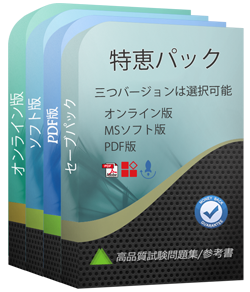70-582試験学習資料を開発する専業チーム
私たちは70-582試験認定分野でよく知られる会社として、プロのチームにWindows Embedded Standard 7 for Developers試験復習問題の研究と開発に専念する多くの専門家があります。したがって、我々のMCTS試験学習資料が70-582試験の一流復習資料であることを保証することができます。私たちは、MCTS 70-582試験サンプル問題の研究に約10年間集中して、候補者が70-582試験に合格するという目標を決して変更しません。私たちの70-582試験学習資料の質は、Microsoft専門家の努力によって保証されています。それで、あなたは弊社を信じて、我々のWindows Embedded Standard 7 for Developers最新テスト問題集を選んでいます。
無料デモをごダウンロードいただけます
様々な復習資料が市場に出ていることから、多くの候補者は、どの資料が適切かを知りません。この状況を考慮に入れて、私たちはMicrosoft 70-582の無料ダウンロードデモを候補者に提供します。弊社のウェブサイトにアクセスしてWindows Embedded Standard 7 for Developersデモをダウンロードするだけで、70-582試験復習問題を購入するかどうかを判断するのに役立ちます。多数の新旧の顧客の訪問が当社の能力を証明しています。私たちの70-582試験の学習教材は、私たちの市場におけるファーストクラスのものであり、あなたにとっても良い選択だと確信しています。
Windows Embedded Standard 7 for Developers試験学習資料での高い復習効率
ほとんどの候補者にとって、特にオフィスワーカー、70-582試験の準備は、多くの時間とエネルギーを必要とする難しい作業です。だから、適切な70-582試験資料を選択することは、70-582試験にうまく合格するのに重要です。高い正確率がある70-582有効学習資料によって、候補者はWindows Embedded Standard 7 for Developers試験のキーポイントを捉え、試験の内容を熟知します。あなたは約2日の時間をかけて我々の70-582試験学習資料を練習し、70-582試験に簡単でパスします。
Tech4Examはどんな学習資料を提供していますか?
現代技術は人々の生活と働きの仕方を革新します(70-582試験学習資料)。 広く普及しているオンラインシステムとプラットフォームは最近の現象となり、IT業界は最も見通しがある業界(70-582試験認定)となっています。 企業や機関では、候補者に優れた教育の背景が必要であるという事実にもかかわらず、プロフェッショナル認定のようなその他の要件があります。それを考慮すると、適切なMicrosoft Windows Embedded Standard 7 for Developers試験認定は候補者が高給と昇進を得られるのを助けます。
70-582試験認定を取られるメリット
ほとんどの企業では従業員が専門試験の認定資格を取得する必要があるため、70-582試験の認定資格がどれほど重要であるかわかります。テストに合格すれば、昇進のチャンスとより高い給料を得ることができます。あなたのプロフェッショナルな能力が権威によって認められると、それはあなたが急速に発展している情報技術に優れていることを意味し、上司や大学から注目を受けます。より明るい未来とより良い生活のために私たちの信頼性の高い70-582最新試験問題集を選択しましょう。
Microsoft Windows Embedded Standard 7 for Developers 認定 70-582 試験問題:
1. A Windows Embedded Standard 7 image is deployed to Ethernet-enabled, handheld devices.
You need to ensure that the devices can be updated periodically without being re-imaged.
What should you do?
A) Create an answer file and a configuration set by using the updated packages. Run the PkgScn/Get-Packages /ConfigSetDir:<path to configuration set answer file> command on each device.
B) Create an answer file by using the updated packages. From the %SystemRoot%\System32\Sysprep directory, run the Sysprep /unattend:AutoUnattend.xml command on each device.
C) Run the Pkgscn /Find-Updates /PackagePath:<path to packages> /ConfigSetDir:<path to configuration set> command on each device to create a configuration set. Run the DISM /online /Apply_Unattend:AutoUnattend.xml command by using the answer file for the configuration set.
D) Create a distribution share
by
using the
updated packages.
Re-configure the images answer file to point to the new distribution share. Start each device to WindowsPE and run the setup /unattend:AutoUnattend.xml command.
2. You are updating a Windows Embedded Standard 7 device offline. You need to remove outdated files from previous updates on the device. What should you do?
A) Run the lmageX.exe tool along with the /delete option.
B) Run the DISM tool along with the /Get-Packages option. Use the DISM tool along with the/Remove-Package option to remove all packages that are found.
C) Run the Package Scanner tool along with the /Get-Packages option to generate an answer file. Use the DISM tool to apply the answer file.
D) Run the Package Scanner tool along with the /Find-Scavenge option to generate an answer file. Use the DISM tool to apply the answer file.
3. You have a Windows Embedded Standard 7 Windows Image (WIM) file generated from a target device. The file is too large to be stored on the USB media that will be used for deployment. You need to reduce the size of the WIM file for deployment on target devices. Which tool and switches should you use when specifying the original WIM file as the input?
A) the lmageX.exe tool along with the /CAPTURE and /COMPRESS maximum switches
B) the DISM tool along with the /Cleanup-Wim and /Online switches
C) the lmageX.exe tool along with the /EXPORT and /COMPRESS maximum switches
D) the DISM tool along with the /Cleanup-Wim and /Commit-Wim switches
4. You are creating an answer file for a Windows Embedded Standard 7 image by using Image Configuration Editor (ICE). The device that contains the image has limited storage. You need to resolve all dependencies manually to ensure that the size of the resulting image is within the storage limit. What should you use to validate the answer file?
A) the Add Required Packages level
B) the Add Required and Optional Packages level
C) the Static Dependency Analyzer tool
D) the Validate Only level
5. You deploy devices that run the same Windows Embedded Standard 7 image. You need to enable or disable package features in a single device without re-imaging the device. You want to achieve this goal by using the minimum amount of administrative effort. What should you do?
A) Run the DISM /online /Add-Package /PackagePath:<"package.cab"> command to enable a feature. Run the DISM /online /Remove- Package /PackageName:<feature name in image> command to disable a feature.
B) From the answer file for the image, open the Properties page for the feature and set the Disabled option to True. Run the DISM /online /Apply_Unattend:<"answerfile.xml"> command.
C) Run the DISM /online /Enable-Feature /FeatureName:<feature> command to enable a feature. Run the DISM /online /Disable- Feature /FeatureName:<feature> command to disable a feature.
D) Create separate custom answer files that have a specific set of features for each device. Run the DISM /online /Apply_Unattend:<"custom_answerfile.xml"> command to enable or disable features based on the custom answer file.
質問と回答:
| 質問 # 1 正解: C | 質問 # 2 正解: D | 質問 # 3 正解: C | 質問 # 4 正解: D | 質問 # 5 正解: C |


 弊社は製品に自信を持っており、面倒な製品を提供していません。
弊社は製品に自信を持っており、面倒な製品を提供していません。


 Seto
Seto


